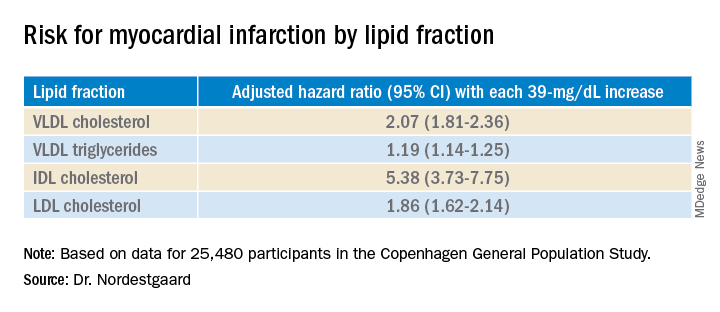New oracles?
Evidence has pointed to triglyceride-rich remnants or VLDL cholesterol as contributing to atherosclerotic CVD, together with LDL-C, but it is “unclear which fraction of risk is explained by, respectively, cholesterol and triglycerides in VLDL,” write the authors of the Copenhagen population study.
Dr. Nordestgaard said their study was motivated by an awareness that “in clinical practice, the focus for lipid-related risk is almost solely on reduction of LDL-C for prevention of ASCVD,” so the current focus needs to be reevaluated because patients with low LDL-C but elevated VLDL cholesterol and plasma triglycerides “may not be offered adequate preventive lipid-lowering therapy in order to prevent future MI and ASCVD.”
His group therefore tested the hypothesis that VLDL cholesterol and triglycerides may each explain part of the MI risk from apoB-containing lipoproteins.
They used measurements of plasma apoB and cholesterol and triglyceride content of VLDL cholesterol, intermediate-density-lipoprotein cholesterol, and LDL-C in the study participants (N = 25,480, median age 61 years, 53% female), who were required to be free of MI and not receiving lipid-lowering therapy at baseline.
During a median 11-year follow-up period, 1,816 participants experienced an MI. They tended to be older, compared with those who did not experience an MI, and also more likely to be male, to smoke, and to have higher systolic blood pressure.
Each 39-mg/dL increase in lipid level was found to be associated with higher MI risk.
The researchers looked at MI-associated risk of specific subfractions of apoB-containing lipoproteins. “VLDL cholesterol explained half of the MI risk from elevated apoB-containing lipoproteins, and [intermediate-density-lipoprotein] and LDL-C together accounted for only 29% of the risk,” Dr. Nordestgaard said.
“If LDL cholesterol is adequately reduced, clinicians need to evaluate possible elevated triglyceride-rich lipoproteins, either as elevated plasma triglycerides, remnant cholesterol, or elevated VLDL cholesterol; and, if elevated, consideration should also be given to reduction of triglyceride-rich lipoproteins,” he advised.
The Copenhagen General Population study was funded by the Danish Heart Foundation and the Novo Nordisk Foundation. Dr. Nordestgaard disclosed consulting for AstraZeneca, Sanofi, Regeneron, Akcea, Amgen, Kowa, Denka Seiken, Amarin, Novartis, Novo Nordisk, and Silence Therapeutrics. PREDIMED was supported by grants from the Instituto de Salud Carlos III- FEDER, Fundació La Marató de TV3, and Agència de Gestió d’Ajuts Universitaris i de Recerca. Dr. Fitó Colomer disclosed no relevant financial relationships. Dr. Burnett disclosed no relevant financial relationships.
A version of this article first appeared on Medscape.com.

